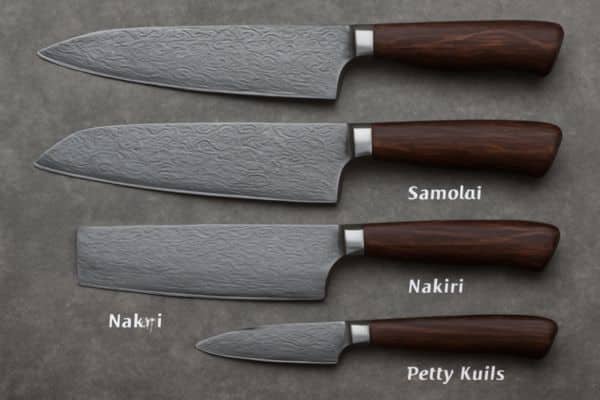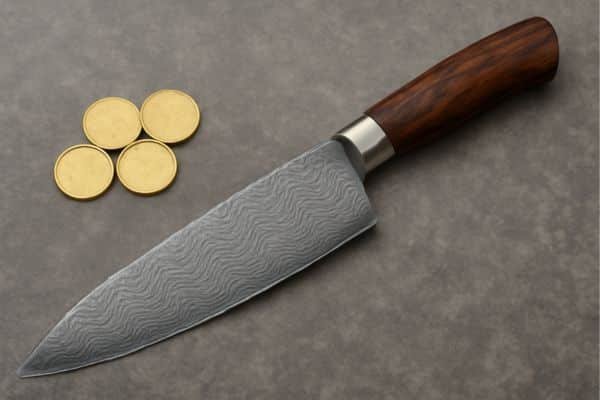I still remember the day my old kitchen knife gave up. I pressed it into a tomato, and it squashed instead of being sliced. That tiny moment sparked a journey. I didn’t expect to care this much about kitchen knife material, but I did. Everything changed the first time I held a Damascus steel kitchen knife. The weight felt just right. The blade moved like butter through carrots, onions, and even meat. That wasn’t just a knife—it was a quiet upgrade to how I cooked. Friends often ask about that patterned knife on my counter: Is Damascus steel good for kitchen knives? The answer is yes—but there’s more to the story.In this article, I’ll share what makes Damascus steel special.
What Is Damascus Steel?
Damascus steel looks like a work of art. Its blade has wave-like lines that twist and turn. These patterns come from how the metal is made. It starts with thin sheets of steel stacked together.
Makers heat the stack until it glows. Then they fold, hammer, and shape it again and again. Each layer bonds with the next. The more they fold, the more patterns appear. The final step is a light acid wash. That brings the waves to life.
So, Is Damascus Steel Good for Kitchen Knives?

Yes. Damascus steel is a solid choice for kitchen knives. It looks great, feels good, and cuts clean. But there’s more to know before you buy one.
Let’s start with the pros. Damascus knives stay sharp for a long time. That’s called edge retention. You won’t need to sharpen it as often as other blades. The balance also feels smooth in the hand. It glides through food with less pressure. That makes prep faster and more fun.
And the look? It’s hard to beat. The waves on the blade are more than just decoration. They show how the steel was made—folded and forged layer by layer. It’s like holding a story in your hand.
Now for the cons. A good Damascus knife costs more than basic ones. You also need to care for it right. Wipe it dry after each use. Don’t toss it in the sink or dishwasher. The layered steel can stain or rust if left wet.
How Damascus Steel Compares to Other Knife Materials
Buying a kitchen knife is like choosing shoes. One style doesn’t fit all. Each blade has its own feel, strength, and use. Let’s break it down.
Damascus vs Stainless Steel
Stainless steel knives are tough and easy to clean. They don’t rust much, even with water and acid. They work well for daily chopping and don’t need much care. But they often lose sharpness faster.
It steel stays sharper for longer. It feels smoother on the board. The patterns also add a touch of style. You’ll need to dry it fast after use, though. That’s the trade.
Damascus vs High-Carbon Steel
High-carbon blades are super sharp. They slice like a dream. But they rust fast and need oiling. One wrong move, and the blade can chip.
It blends both worlds. It often has a high-carbon core with a layered shell. That adds strength without giving up sharpness. It’s like giving the blade armor.
Damascus vs Ceramic
Ceramic knives are sharp and light. They don’t rust. But they’re brittle. Drop one on the floor—it may crack. You can’t sharpen it at home, either.
Knives are stronger and last longer. They handle more jobs without chipping. You’ll get a better grip and a better feel.
Types of Damascus Kitchen Knives & When to Use Each

Every job in the kitchen has its tool. Knives are no different. Each shape helps with a different task. Let’s look at the most common types of knives and how to use them.
Gyuto (Chef’s Knife)
This is the all-rounder. It handles meat, veggies, herbs, and more. You’ll reach for it most days.
Santoku
This knife is shorter and lighter than the Gyuto. The tip curves less, which makes it better for fast, clean chops.
Nakiri
This one has a flat edge and square tip. It’s made for straight up-and-down cuts. You won’t rock it like a chef’s knife.
Petty Knife
The Petty is like a mini chef’s knife. It’s small and sharp. Easy to control for tiny tasks.
How to Care for a Damascus Steel Knife (Made Simple)
A knife needs care, but it’s not hard. Think of it like a cast-iron pan. A bit of love keeps it strong for years.
Cleaning (No Dishwasher!)
Always wash by hand. Warm water. Mild soap. Soft sponge. Dry it right away. That stops rust before it starts.
Never leave it wet or soaking. No dishwashers. No harsh scrubs. These can dull the blade and damage the pattern.
Honing and Sharpening
Use a ceramic rod to hone the edge. That means keeping it straight—not grinding it down. Do this every few uses.
For sharpening, use a whetstone. Start with coarse, then fine. Move the blade in slow, even strokes. Take your time. Let the stone do the work.
Storage and Safety
Store it in a knife block, magnetic strip, or blade guard. Never toss it in a drawer. That’s how edges get chipped.
Keep it away from heat and damp places. Treat it like the tool it is—precise, strong, and crafted to last.
Beginner Buying Tips: What to Look for in a Knife

Buying your first Damascus knife feels exciting, but also a bit tricky. There are lots of choices out there. Some look fancy but cut like butter knives. Others cost too much for what they offer. Here’s what to check before you click buy.
Price Range for Good Quality
You don’t need to spend a fortune. A solid Damascus kitchen knife starts at around $60 to $100. That gives you a real layered blade, not just a printed pattern.
Quick Tip: The best kitchen knife set under 100 often includes one quality Damascus knife. Perfect for starting your collection.
Trusted Brands and Signs of Quality
Look for full-tang construction. That means the metal runs through the whole handle. It feels stronger and lasts longer. A real layered blade will show patterns on the spine and not just the sides.
Conclusion
Damascus knives offer sharpness, beauty, and strength in one blade. They cut clean, feel balanced, and stay sharp longer than many others. The layered look adds charm to your kitchen.
These knives work well for home cooks and hobby chefs. Even gift buyers will find value in their style and use. They’re not just tools—they’re a joy to hold.
You’ll need to care for them. A quick wash and dry after each use keeps them looking great. Store them right, and they last for years.
I use mine every day. It changed how I cook. I now enjoy slicing, chopping, and even meal prep. Yes, I recommend it.

